Few prasadam stories from New Vrindaban’s history are as legendary as those of the late Amburish Dasa’s sweet rice and Pitambar Dasi’s ice cream.
Straight from the cow barn and prepared by the cowherd couple with deep love and devotion, they were much-craved treats in the austere lives of New Vrindaban’s early devotees.
Neither Amburish nor Pitambar had any cooking or cow-care experience before becoming devotees. Amburish, a city boy from Denver, Colorado, stopped at New Vrindaban on a road trip in 1971 just after high school, and instantly knew he was home. He moved to New Vrindaban and was initiated by Srila Prabhupada that same year.
Pitambar met devotees chanting at a craft show while living as a hippy in California’s Santa Cruz mountains. When one of the devotees told her all about New Vrindaban, she was similarly drawn to the place – she stayed over night at her first visit on Radhastami 1976, and never left.
Soon after, she received the service of caring for the calves, and met her husband-to-be Amburish in the barn, where he was in charge of the cows.
Amburish made an instant impression. An excellent kirtan leader and pujari, he was well known for his dedication, hard work and enthusiasm. “He could often be seen running from one service to another,” recalls his long-time friend Advaita Das. “He did not walk, he ran.”
But most of all, Amburish loved serving the cows.
“They were his heart and soul,” Pitambar says. “They weren’t just cows, they were like mirrors of his family. There were hundreds of them, and he named them all, and remembered their names. He involved our children, too – when our first son was born, he sat him on a cow when he was just two hours old. And our three sons – Nitai, Acarya and Anandamaya – were always playing in the barn while we were milking.”
Throughout the 1970s and early 1980s, Amburish kept meticulous records of all the cows’ activities, births, deaths, names, locations, and milk production amounts. He worked in the barn from early morning till late at night. He attended veterinarian school, so that he could deliver and breed the cows, and take care of all their medical needs.
And he saw Krishna in all of it. “He would tell us, ‘When you clean the barn, clean it so nicely that Krishna will want to bring Radharani here to take a walk through it,’” Pitambar says. “He would blast out the Govindam prayers to call the cows in from the pasture. And he always chanted while milking them.”
The fresh, whole milk from cows protected with such love and devotion was an essential part of Amburish’s legendary sweet rice.
But so, too, was the way he applied that same care and devotion to preparing the dish.
“First he would go take a shower, and get dressed in his dhoti and brahmana thread, as if he was getting ready for pujari work,” says Pitambar.
Then Amburish would carefully measure out all the ingredients, which at different times included spices like bay leaves, camphor, and cardamom but eventually were reduced to a pure blend of just four items: fresh milk, rice, sugar and raisins.
Cooking outside over a wood fire in a huge 30 gallon pot, he would alternately scrape the bottom of the pot to keep the sweet rice from burning, and aerate the milk with a one gallon ladle. Consistency was king, and Amburish wanted it to be perfect. Meanwhile, he chanted bhajans the entire time without cessation.
“It was just so magical to watch,” says Pitambar.
Depending on the time of year, Amburish would then cool the sweet rice in a stream, a root cellar, or a snowbank. The resulting dish was a Sunday or festival treat that inspired feverish devotion in a New Vrindaban community that lived on an austere diet during the week. One tradition on Balarama Rasayatra saw Amburish hiding the sweet rice out in the pasture for Lord Balarama and his Gopis, which the devotees would hunt desperately for at night, to no avail.
“I had experienced sweet rice before, but Amburish’s sweet rice took the experience to a new level,” says Advaita. “To this day I have never tasted sweet rice anywhere – at any other temple or restaurant – that even comes close.”
Another much sought-after treat was Pitambar’s ice cream, rich in flavor as it was also made with the excess milk from Krishna’s cows. “I would blend milk, sugar and fruit in an ice cream machine, put it in a five-gallon bucket, take it to the prasadam room, and sell it for 35 cents a cup,” she says. “Back then, it was so austere, that anything sweet was like, ‘Oh, boy!’ What’s more, it was something different – not on the Vedic menu. The cups just flew out!”
For New Vrindaban’s three biggest festivals at the time – Memorial Day, Fourth of July, and Labor Day, which all ran over three-day weekends and drew thousands of devotees, pilgrims and tourists – Pitambar would make an incredible 100 gallons of ice cream a day.
“I would stay up for three days straight, not sleeping at all, to make it,” she says. “I’d have to make it only four gallons at a time, because that’s all the milk the machine would hold. And I made a different flavor of ice cream each day: carob, using a Hershey-like syrup; strawberry; and orange-mango, using real fruits rather than concentrate.”
Pitambar also worked extremely hard the rest of the year, too. In the early days, she made chapatis and washed pots, scrubbing them with ashes from the cooking fires because there was no soap.
From left to right Acarya, Amburish, Ananda, Pitambar, Nitai, circa 1986 in the living room of what is now Nityodita’s House New Vrindaban
Later, she took care of the calves as diligently as Amburish did the cows. “I just loved them,” she says. “They were like my children. They were so much fun, and so sweet. I would feed them bottles of milk, and I’d look down, and my entire sari would be in their mouth!”
Pitambar also cleaned the calves’ pens, brushed them, and fed them grain and hay as they got older, walking from one farm to another to care for calves of different age groups.
They were inseperable. At one point early on before she was married, Pitambar attempted to leave New Vrindaban and move to the temple in Berkely, California. “Then I dreamt about the calves,” she recalls. “They were crying, asking me to come back. I started packing my bags right away. The Berkely leaders begged me to stay, offering me trips to India, saris, a new apartment. I said, ‘No, I have to go back to my calves!”
Pitambar also made ghee and milk sweets from New Vrindaban cow milk for the Deities and guests, and churned butter by hand. She had to churn it in a stream in the summer to keep it cool, and on the coals of the cooking fires in the winter to keep it from solidifying.
From 1976 to 1980, she and Amburish ran a full snack bar from the barn, with her ice cream, French fries cooked in ghee, Bhima burgers, and pizza with home-made cheese. During this period, she also worked at Prabhupada’s Palace until its opening in 1979, doing gold-leaf and touching up moldings.
Procession moving RVC to current temple July 4th Weekend 1983 in New Vrindaban Pitambar is leading Sita Cow.
From 1983 to ’84, Amburish and Pitambar oversaw the teenage boys’ ashram, which Pitambar says was ‘like a big, happy family.’
Former students agree. “We lived at the Vrindaban farmhouse, which, at the time, was quite remote and removed from the rest of the community,” says alumni Chaitanya Mangala Das. “This meant the adolescent boys were able to engage in a lot more fun activities that weren’t really allowed before or after that period. For those in that ashram there is a general consensus this was our favorite time in gurukula, and Pitambar and Amburish were our favorite ashram teachers.”
Later, the couple worked at ISKCON’s restaurant in Pittsburgh, and supplied the Rainbow Kitchen for the homeless with food.
In 1989, Amburish passed away in New Vrindaban, and his ashes were scattered at the Kusum Sarovara Lake there.
In his absence, Pitambar started her own herbal goods cottage business to support herself and her boys. Taking her tinctures, homeopathic medicines, dried flower arrangements and herbal-infused creations to local craft fairs she worked hard and became well-known in the area, making the cover of the Wheeling Register.
In 2001, she finally left New Vrindaban to take care of her mother in Pittsburgh. Today, she still lives there while her son Nitai and other caregivers take care of her, as her advanced Parkinson’s leaves her disabled and homebound.
“Pitambar is a kindhearted, gentle and humble devotee, whose caregivers say she has ‘taught them a lot about life,’” says Pitambar’s closest friend Tilakini Dasi, who calls every day to keep her spirits up.
“She’s a generous and empathetic soul who cares a lot about others, and a fiercely dedicated mother,” adds Rupa Dasi, another lifelong friend.
Sure enough, Pitambar herself hopes she’ll be remembered for always trying to be kind to everyone, and says that being a mother was her favorite and most important service.
She is very proud of her grown-up sons Nitai, who works at an irrigation company as well as caring for her; Acarya, who serves in the U.S. Navy; and Ananda, a former combat medic, who recently got engaged and is now attending ultrasound tech school.
“They might have very different lives now than they did growing up,” Pitambar says. “But Ananda says his happy place will always be laying on a blanket in Radha-Vrindaban Chandra’s temple room during mangala arati.”
New Vrindaban is Pitambar’s happy place, too. “It’s where I spent most of my adult life,” she says. “There was good and bad there, but it was home. I miss it terribly. I wish I could physically go there more, but my health won’t currently allow it.”
Pitambar has potent advice for the next wave of New Vrindaban residents. “Our lives are precious and go by fast. We don’t always know Krishna’s plan, so we should use our time wisely.”
She concludes, “New Vrindaban is a very special place. It is the home of Srila Prabhupada, Sri Sri Radha Vrindaban Chandra, and so many wonderful Brijabasis. So please, let’s do our best to love and respect each other in the Holy Dhama.”
Amburish’s Heavenly Sweet Rice
(Makes about 12 cups)
“Of the many wonderful dairy-based recipes from the pioneer days of New Vrindaban, Amburish’s sweet rice remains my all-time favorite,” Pitambar says. “Of course, the most important ingredient was his enthusiastic devotion, every time he made it. Made with the same care, this heavenly sweet rice is a wonderful way to honor Lord Krishna, His cows and cowherds.”
Ingredients:
1 gallon fresh milk (whole milk, from protected cows, if possible)
1 cup long grain rice (creates a better consistency and flavor than basmati)
3 cups white sugar (cut down if too sweet)
Small palm full of raisins
Directions:
Combine milk and rice in a thick-bottomed pot. Cook on a medium heat, making sure to scrape the bottom of the pot constantly so that the milk will not stick and burn. When the milk begins to boil, begin ladling the milk as well as stirring it – this serves to aerate the milk and keep it from boiling over.
After half an hour, add raisins. When the mixture has been cooking for about 45 minutes, begin watching it closely. Consistency is key – it should be neither too thin nor too thick. Pick up some of the sweet rice in the ladle, swish it around, and check that the rice is floating on top of the milk and that the milk itself leaves a thin coating on the ladle.
When it reaches this point, remove the sweet rice from the fire and stir the sugar in thoroughly.
Chill the sweet rice, offer to the Lord and serve ice cold.
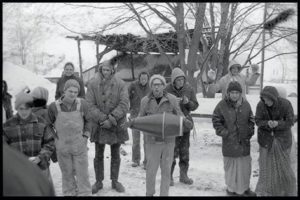
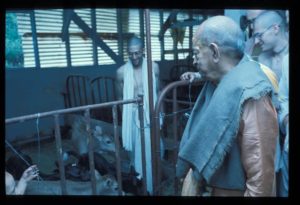
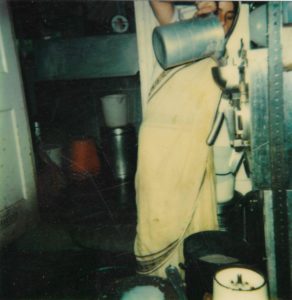
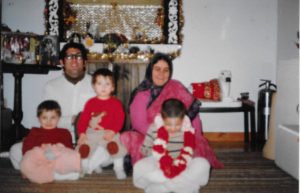
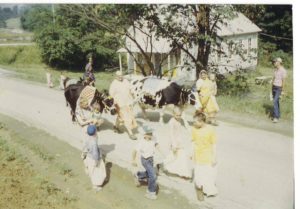
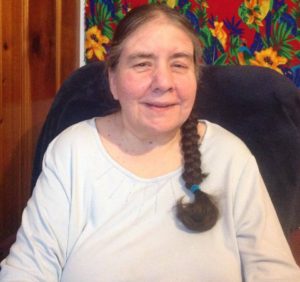
Comments